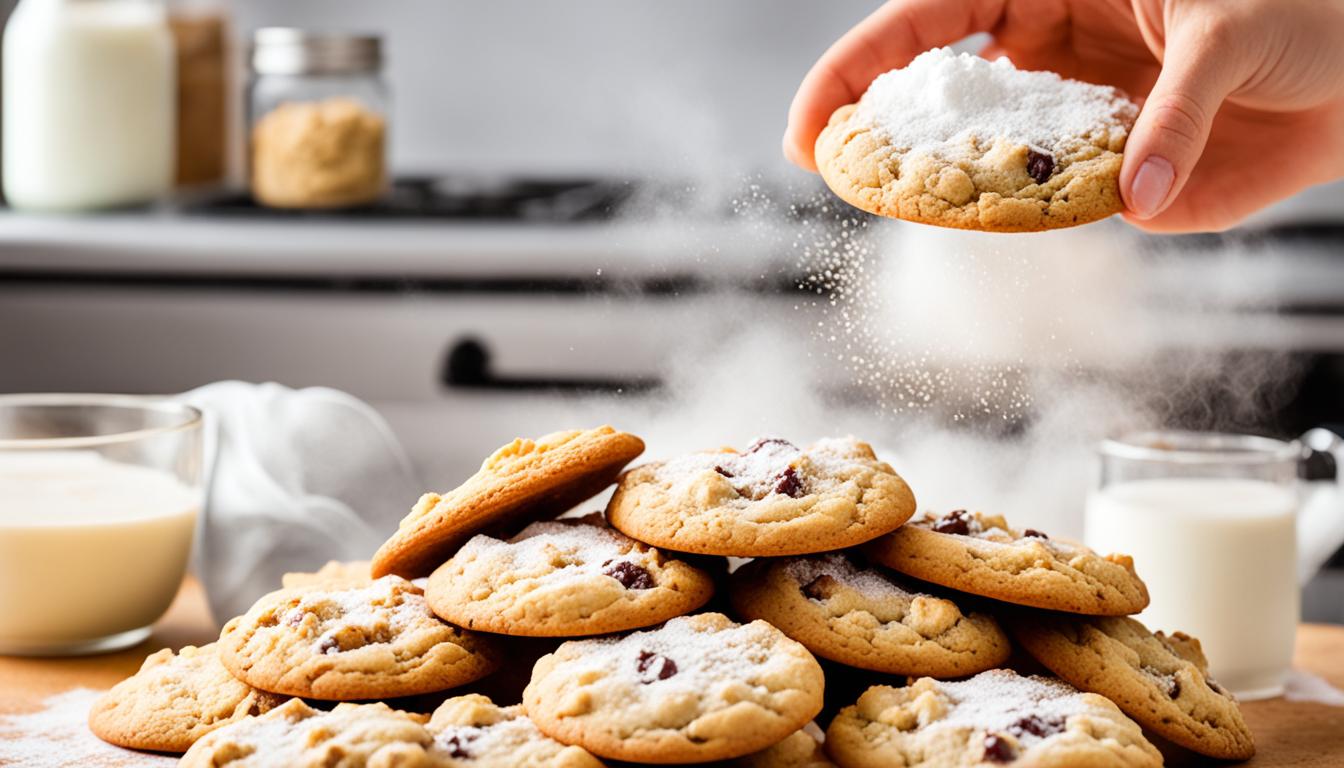Have you ever wondered why some cookies turn out light and fluffy, while others are flat and crumbly? The answer lies in a humble ingredient called baking powder. But what exactly is the role of baking powder in cookies? How does it work its magic to create those perfect treats we all love? Prepare to delve into the fascinating world of cookie science, as we uncover the secrets behind baking powder and its impact on your favorite baked goodies.
Key Takeaways:
- Baking powder is a vital ingredient in creating light and fluffy cookies.
- It acts as a leavening agent, helping the cookies rise and achieving a desired texture.
- The chemistry behind baking powder involves a chemical reaction that produces carbon dioxide gas when exposed to moisture and heat.
- Accurate measurement and freshness of baking powder are essential for optimal results.
- Alternative ingredients can be used in place of baking powder, but they may affect the taste and texture of the cookies.
The Chemistry Behind Baking Powder
Baking powder is a key ingredient in creating the perfect cookies. Understanding the chemistry behind this leavening agent can help you achieve the desired texture and rise in your baked goods. Let’s dive into the science behind baking powder.
Baking powder consists of two main components: an alkaline ingredient, such as baking soda (sodium bicarbonate), and an acid ingredient, such as cream of tartar (potassium bitartrate). When these ingredients come into contact with moisture and heat, a chemical reaction occurs.
The reaction between the alkaline and acid components of baking powder produces carbon dioxide gas. This gas gets trapped within the dough or batter, causing it to expand and create air pockets. These air pockets contribute to the rising of the cookies, resulting in a light and fluffy texture.
“When moisture and heat combine with baking powder, a chemical reaction occurs, producing carbon dioxide gas. This gas causes the dough or batter to rise, resulting in light and airy cookies.”
It’s worth noting that if you don’t have baking powder on hand, you can create a substitute by combining baking soda with an acid, such as cream of tartar. This homemade substitute can be used in a pinch and will produce similar results in your cookies.
Now that we understand the chemistry behind baking powder, let’s explore some other tips for baking with this essential ingredient. But before we move on, take a look at the image below, which visually represents the chemical reaction that occurs when baking powder is used in baking:
Tips for Baking with Baking Powder
To achieve the best results when baking cookies with baking powder, there are a few tips to keep in mind.
- Measure Accurately: Be sure to measure the baking powder accurately, as too much or too little can significantly affect the texture of your cookies. Following the recipe instructions precisely will help you achieve the desired results.
- Use Fresh Baking Powder: Freshness is crucial when it comes to baking powder. Over time, it loses its effectiveness, resulting in cookies that may not rise properly. Check the expiration date on the packaging and ensure you’re using a fresh batch.
- Experiment with Brands: Different brands of baking powder may yield slightly different results in terms of texture and rise. Consider experimenting with different brands to find the one that works best for your cookie recipes. Don’t be afraid to try a few options to discover your favorite.
Incorporating these tips into your cookie baking routine will help you achieve cookies with the perfect texture and rise, ensuring a delightful treat for everyone.
Here’s an example of how inaccurate measurement of baking powder can affect your cookies:
| Measurement | Resulting Texture |
|---|---|
| Too Much Baking Powder | Puffy and cake-like texture, but with a bitter taste. |
| Too Little Baking Powder | Dense and flat texture, lacking in rise. |
By measuring accurately and considering the freshness and brand of your baking powder, you can ensure that each batch of cookies turns out just right.
Exploring Baking Powder Alternatives
While baking powder is commonly used as a leavening agent in cookie recipes, there are alternatives available. If you’re looking for a natural option, you can use baking soda combined with an acidic ingredient, such as lemon juice or vinegar. This combination will create a similar reaction and help the cookies rise. Another option is self-rising flour, which already contains baking powder. However, it’s important to note that using alternative ingredients may affect the taste and texture of the cookies, so it may require some trial and error to achieve the desired results.
When experimenting with baking powder substitutes for cookies, it’s essential to consider taste, texture, and overall baking experience. While baking soda combined with an acid can provide the necessary leavening, it may impart a slightly different flavor profile to your cookies. The acidity of lemon juice or vinegar adds a tangy element and can enhance certain flavors, so it’s best suited for recipes where this flavor profile is desired. However, for those who prefer a more neutral taste, self-rising flour can be an excellent option, as it eliminates the need to add baking powder separately.
In the table below, we compare the characteristics of baking powder alternatives to help you make an informed decision when substituting ingredients:
| Ingredient | Leavening Power | Taste | Texture |
|---|---|---|---|
| Baking Soda + Acid (e.g., lemon juice or vinegar) | Good | Tangy | Light and airy |
| Self-rising Flour | Moderate | Neutral | Slightly denser |
While these alternatives can be effective, it’s essential to remember that baking powder has some unique properties that may be difficult to replicate. Its ability to provide consistent, reliable results with minimal impact on flavor makes it a favorite among bakers. However, exploring alternatives can be an exciting way to experiment with different flavors and textures in your cookies.
The Impact of Baking Powder on Cookie Texture
Adding baking powder to cookie recipes can have a significant impact on the texture of the cookies. It helps create a soft and tender center, while still allowing for a crispy edge. The amount of baking powder used can determine the level of puffiness and cakiness in the cookies. Additionally, the type of cookie recipe and other ingredients used, such as sugar and butter, can also influence the final texture. Understanding the ratio of baking powder to other ingredients is key to achieving the desired texture in cookies.
When baking cookies, the chemistry behind the interaction of baking powder with the other ingredients is crucial. Baking powder contains an alkaline component (such as baking soda) and an acid component (such as cream of tartar). When combined with moisture and heat, these ingredients undergo a chemical reaction, producing carbon dioxide gas. The trapped gas creates air pockets in the dough or batter, resulting in the cookies rising and becoming light and fluffy.
“Adding just the right amount of baking powder can help you achieve the perfect texture in your cookies.”
The ratio of baking powder to other ingredients can vary depending on the desired texture. For a puffier and cakier cookie, a higher amount of baking powder can be used. However, it’s important to note that using too much baking powder can lead to a bitter taste in the cookies and cause them to spread excessively. On the other hand, using too little baking powder may result in denser and flatter cookies.
“Achieving balance with baking powder is essential to strike the perfect texture balance in your cookies.”
In addition to the ratio of baking powder, the type of cookie recipe and other ingredients used can also influence the final texture. For example, using granulated sugar in the recipe can create a crispier texture, while brown sugar can contribute to a softer and chewier texture. The amount of butter or fat used can also affect the texture, as more butter can result in a softer and more tender cookie.
“Consider experimenting with different ingredients to find the perfect combination for your ideal cookie texture.”
Being aware of the impact of baking powder on cookie texture allows you to adjust the amount and other ingredients to achieve the desired results. Whether you prefer a soft and fluffy cookie or a crispy and chewy one, understanding the cookie chemistry and following the right techniques will enable you to create delicious treats that satisfy your taste buds.

“The right balance of baking powder can make all the difference in creating the perfect texture for your cookies.”
The Legacy of Eben Horsford and Baking Powder
Eben Horsford, a chemist and professor, played a significant role in the study and development of baking powder. His dedication to understanding the science behind this essential ingredient has had a lasting impact on baking as we know it today.
Through meticulous experiments, Horsford unraveled the mysteries of the leavening agent and its effects on baked goods. In particular, he focused on the role of baking powder in cookies, examining how it interacts with other ingredients like flour and sugar.
“Baking powder is not just a simple addition to the recipe. Its chemical reactions with other ingredients are what make cookies rise and provide them with their unique texture,” Horsford once said.
Horsford’s groundbreaking research paved the way for a deeper understanding of the chemical reactions at play in baking. He discovered how the combination of an alkali, such as baking soda, and an acid, like cream of tartar, creates carbon dioxide gas when exposed to moisture and heat.
This gas is what causes cookies to rise, creating the desired light, fluffy texture. By carefully studying the role of baking powder in cookies, Horsford laid the foundation for modern baking techniques and revolutionized the way we approach cookie baking.
Demonstration: The Impact of Baking Powder
In one of his most famous experiments, Horsford showcased the transformative power of baking powder. He prepared two batches of cookies, one with baking powder and the other without. The difference was remarkable.
The batch with baking powder produced cookies that were light, fluffy, and perfectly risen, while the batch without had a denser, flatter texture. This experiment effectively demonstrated the crucial role baking powder plays in achieving the desired cookie texture.
Horsford’s dedication to understanding the science behind baking powder has left a lasting legacy. Today, his research continues to shape our knowledge of the chemical reactions that occur during the baking process and reinforces the importance of using baking powder in cookie recipes.

| Baking Powder Experiment Results | Cookies with Baking Powder | Cookies without Baking Powder |
|---|---|---|
| Texture | Light and fluffy | Dense and flat |
| Rise | Perfectly risen | Minimal rise |
| Taste | Delicious and well-balanced | Dense and lacking flavor |
Conclusion
In conclusion, baking powder plays a crucial role in achieving the perfect cookies. Its leavening properties help cookies rise and create a light and fluffy texture. By understanding the science behind baking powder and following proper baking techniques, you can elevate your cookie game to new heights.
When it comes to baking with baking powder, accuracy is key. Make sure to measure the baking powder precisely, as using too much or too little can affect the texture of your cookies. Additionally, using fresh baking powder is important to ensure its effectiveness.
Don’t be afraid to experiment with different brands of baking powder or alternative ingredients. This will allow you to find the best option for your recipes and achieve the desired results. With a little knowledge and practice, you can become a master of cookie science and create mouthwatering treats for everyone to enjoy.
